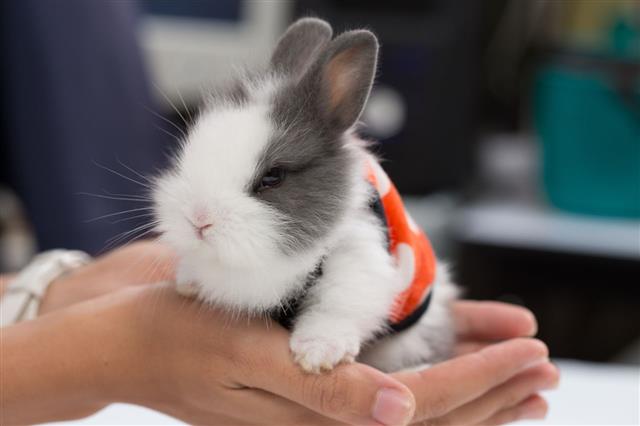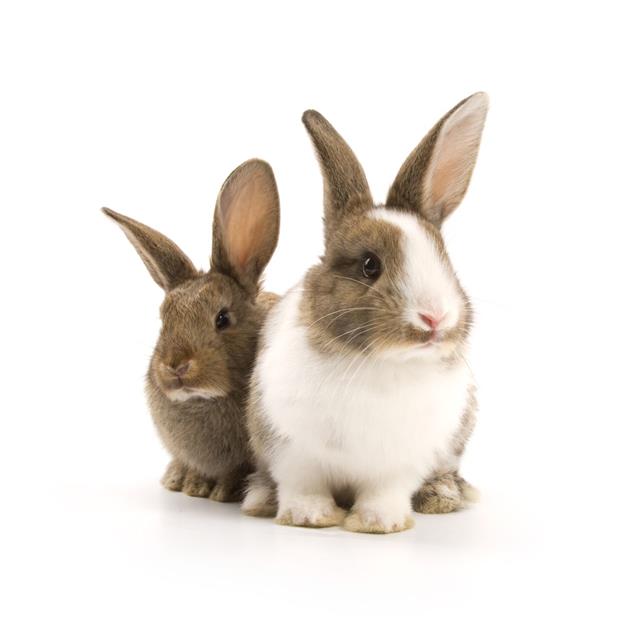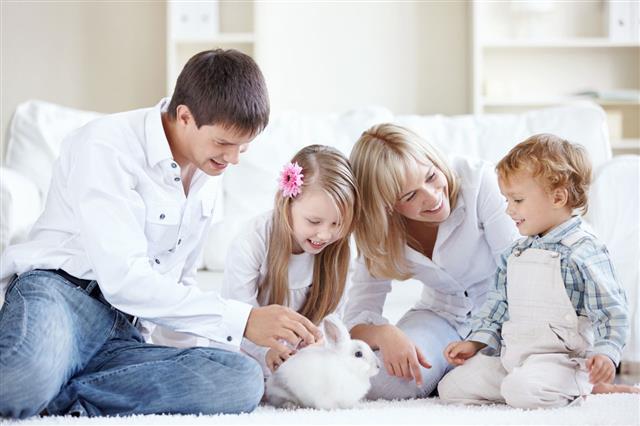
Keeping dwarf bunnies is a trend that is on the rise. If this idea appeals to you, know that these furry little bundles of joy require quite a bit of care. Read the following article to know every bit about these cute bunnies before getting them home.
After dogs and cats, next on the list of popular pets come rabbits. These cuddly little bundles of fur aren’t difficult to care for, but like any other pets, they also require adequate attention. And for that, you have to be well aware about the do’s-and-don’t’s and its positives and negatives. Reading from authentic sources and talking to a few owners can make you familiar with majority of aspects of keeping these animals as pets. Knowing about the existing breeds and their suitability as pets is the first and foremost factor of consideration while choosing bunnies.
The most popular breeds of rabbits as a pet are Netherland Dwarf, Polish Dwarf, Holland Lop, Dwarf Hotot, Lionhead Bunny, Jersey Wooly. These breeds are compatible in terms of space, diet, handling, grooming and over all maintenance.
Bunny Behavior
Biting, growling and even aggressive sniffing indicate anger in your bunny. Along with this, loud teeth-grinding associates pain whereas soft vibrating teeth denote pleasure.
A bunny lying on the floor with one ear raised informs you that it is listening to the sounds around it but is not paying much attention to them.
A bunny rubbing its chin on things shows possession, affection and marks its territory. The scent gland located under the chin is activated when it rubs the chin on other animals, objects and people.
When a dwarf bunny is lying completely stretched with the ears pulled back against the body and eyes closed half way it indicates immense pleasure and relaxation. It tells you that your little bunny will be off to sleep in a short while. So leave it alone to enjoy the moment.
A male bunny hopping around your feet and biting them shows courtship gesture. This is specific to bunnies that are not spayed or neutered.
If your bunny is jumping and twisting in the air, celebrate as you own a very happy and joyous bunny. This typical bunny behavior is referred to as binky by many people.
A curious bunny keeps investigating the world around it and this is evident when the bunny is in the position where its neck is stretched, eyes are widened, ears are in forward direction and legs are stretched back.
Pros and Cons of Owning a Dwarf Bunny
Pros
Being quiet and calm, dwarf bunnies can be friendly pets. They are good for families as well as for children. These cute little creatures are very expressive and exhibit various amusing behavior patterns at several occasions.
The size of dwarf bunnies is another advantage of keeping them in the house. While they possess all the charms and cuteness of larger rabbit breeds, they are easier to handle and care for. Moreover, they are perfect for first-time pet owners as their compact size enables the owner to feed them, pick them up and carry them around.
Cons
Dwarf rabbits are prone to certain diseases which are quite difficult to treat, one of them being the intestinal problems caused due to the formation of hairballs. Dwarf bunnies cannot vomit and hence, a hairball remains in their stomach, causing severe intestinal discomfort. This requires taking proper care of their diet, which involves a lot of efforts.
Myxomatosis is a common viral disease in rabbits, which can cause rapid death. Pet rabbits that are placed outdoors and come in contact with wild rabbits, hares or other animals are more susceptible to this disease. However, it does not mean that the rabbits housed indoors are completely safe because the disease can be transmitted even by a housefly. In order to prevent this disease, arrange annual vaccination for your rabbit.
The average life span of a dwarf bunny is 7 to 10 years, but can occasionally extend to as long as 13 years. This can be a pro or a con depending upon the perspective of the owner whether he is willing to take up a long-term commitment or not.
Pet rabbits can show destructive behavior, especially when they are not caged. Owing to their tendency to dig and chew on things, your walls, furniture, telephone and computer wires are at stake if you are planning to leave them free inside the house.
After weighing the pros and cons, if you have decided to adopt a dwarf bunny, here are some important aspects that will help you select the right bunny to its care and grooming. The following part of the article includes: choosing the right breed, its compatibility with children and other pets, housing and protection and some caring tips.
Choosing the Perfect Dwarf Bunny
There are various factors to consider while buying a dwarf rabbit, one of them being the age. You need to decide how old your bunny should be at the time of purchase. Many people prefer young ones or baby rabbits as they are amusing, mainly for kids and also for other members of the family. However, you need to be more careful with their over all maintenance as compared to older rabbits.
When buying a dwarf rabbit as a pet, adult rabbits are also a good option, provided they are raised in a proper atmosphere and appropriate conditions. You can choose a bunny as young as 4 months and as old as 12 months of age. It is also important to choose the perfect breed as the temperament and maintenance needs differ from one breed to another.
The next major concern is where to buy a dwarf rabbit from. It is advisable to approach a reputed breeder as the animals at this place are likely to have been properly taken care of. Do not consider buying it from a pet shop because the changes in the environment put young rabbits in stressful situations and cause serious digestive problems in them. Apart from this, a breeder is in a better position to guide you on how to care for your pet. The next factor is the health condition of the rabbit at the time of purchase. Ensure that the breed you wish to select does not have any hereditary health problems because some dwarf breeds are at a risk of serious eye and tooth problems. Make sure that the pet shop or the breeder, from whom you are getting your bunny, does not have a stock of breeds with such health problems.
Dwarf Bunny Compatibility with…
… Children
While getting a dwarf bunny for a child might seem like a good idea, there are some points of concern that should not be overlooked. A child would want to hold, cuddle and carry around the animal, which are all very frightening experiences for a dwarf rabbit. This may cause it to scratch or bite, and consequently get dropped. A dwarf bunny that is dropped can break a limb or even its back. To prevent this, it is important to teach the rules of interaction to both the bunny and especially the kids. Initially, let your child sit beside the pet and just stroke it in a gentle manner. If your child is too small to hold a bunny, do not allow him to do it at all and keep reinforcing gentle stroking and petting for some more time.
… Other Pets
Normally, the issue of compatibility rises when you already have another pet in the house and you have to introduce a dwarf bunny to them or vice versa. Different animals react differently when introduced to other animals of the same or different species. Here are some tips on how you can introduce your dwarf bunny to two of the most common household pets – cats and dogs:-
Dog:
- Ensure that the dog is well trained as far as obedience is concerned and follows all your commands or else it is likely to harm your bunny.
- Let your bunny be in its comfortable environment inside the cage.
- Now allow your pet dog to go closer to the cage and let both the pets sniff each other for a while.
- The dog will be eager to know this new member. However, if he/she gets too excited, take him/her away from the cage.
- To inculcate gentle behavior in your dog, talk soothingly and softly while he/she is sniffing the rabbit and praise him/her if he/she behaves in a decent manner.
- Teach your dog that just like the children of the family, the cat and the dog are members of the household the rabbit should also be treated as a new family member and not a prey.
- When the dog gets familiar with the new member, you may be able to leave your bunny free in the house and restrain the dog from attacking, by your commands.
- Please remember that keeping dog and bunny together unwatched can put your little bunny in great danger. Let them be together when you or any other family member is around.
Cat:
- Unlike dogs and dwarf bunnies, cats take a little longer to socialize. Therefore, introducing a bunny to a cat is a bit time-consuming and needs patience. The major aspect here is the size of the rabbit and the cat. A rabbit of the size similar to the cat or larger appears as a threat to the cat hence, the cat will avoid interacting with it.
- On the contrary if the rabbit is smaller in size, the cat will see the bunny as a prey and might attack it.
- Therefore, while introducing them to each other, maintain a safe distance. Keep the bunny in its cage that has very small gaps between the wires so as to prevent the cat from putting its paw inside and scratching the bunny.
- Next important thing is that both these animals should become familiar with each other’s scent and sound by sniffing each other and being kept in each other’s presence, at regular intervals, under proper supervision. This will prevent the cat from interpreting rabbit’s movements or sounds as a signal to attack. The cat should learn that existence of the rabbit in the house is normal and it should not attack the little one.
- Remember that these animals get along very well if they are introduced properly. Have patience and give the entire process sufficient time.
Housing and Protection Cage Structure
One of the primary aspects of dwarf bunny care is setting up a home for it where it will be comfortable and secure. It is not advisable to let your pets run freely in the house, owing to safety concerns. The cage should be at least four feet wide, two feet deep and two feet tall, with a solid bottom. Cover the base with plenty of straw, hay or aspen shavings to create a cozy environment for the bunny. Know that wire-bottom cages can ulcerate a rabbit’s feet. If you have such a cage, cover the base with a piece of wood or corrugated cardboard. Plan to keep the cage indoors, as rabbits can die of heart attacks at the mere sight of what they perceive as a predator.
Cleanliness of the Cage
Provide your dwarf bunny with a newspaper-lined litter box when you litter train it. Ideally, fill it with timothy hay or pelleted-newspaper litter, and change it every day to reduce the strong, unpleasant odor. You may use any grass hay but steer clear of alfalfa, pine/cedar shavings and clay cat litters (both clumping and non-clumping). Also provide your dwarf bunny with a box that it can entertain itself with, or even hide in! Remember that dwarf bunnies are burrowing animals, so they like dark, enclosed spaces. Another instinctual habit of dwarf rabbits is to dig and chew on things, so provide them with chew toys, a digging box, pieces of cardboard, old phone books, etc.
Protection
As dwarf rabbits are the smallest among all rabbit breeds, they are extremely delicate. They can easily get injured by falling and jumping. Hence, they should be handled with utmost care and should be protected from falling. To save them from accidents, you can house them at ground level. Also, the location of their cage should be such that they are not exposed to direct sunlight as they tend to overheat easily. They cannot adapt well to the surroundings, even in winters, if placed outside. Hence, it is always better to arrange their home indoors, irrespective of the weather outside. Apart from this, they also need protection from predatory animals like dogs and cats, especially if they are housed outdoors.
Grooming and Caring Tips
Grooming
Although dwarf bunnies are self groomers, they still need some of regular grooming from you. This involves nail trimming and brushing through the soft fur and contributes to their health and well-being. Nail trimming is important because rabbits have very sharp nails that can cause serious injuries to people and other pets around. Similarly, regular brushing will help remove excess dead hair and prevent hairballs formation (a mass of hair formed in the stomach of animals because of licking fur).
If you do not have the knowledge about grooming your bunny, take it to a reputed vet for its initial grooming. While the vet does the grooming, observe each step carefully as it will help you in the next grooming session. Also, observe the position of the vet and the bunny during the procedure. If you do not hold the bunny in an appropriate manner, it may feel threatened and attack you. To prevent bunny attacks while grooming, talk to the bunny in a gentle tone and make it feel comfortable and enjoy the procedure. Along with brushing and nail trimming, inspection of the eyes, ears and teeth is necessary. If there is any discharge, irritation or redness in the eyes and ears, contact your vet immediately. Similarly, check its teeth once a month and if you feel they are over-grown or suspect any other related problem, visit the vet.
Companion Needs
It is ideal to get your pet dwarf bunnies in pairs. They are sociable animals and enjoy the company of others of their kind. They are always together, right from eating, running around the house to sleeping. Keeping them in pairs also encourages cleanliness through social grooming. Each companion helps the other in cleaning the areas above the head, behind the ears which is otherwise difficult for the bunny to clean on its own.
Handling
Bunnies don’t like to be lifted or carried around, they feel threatened. So, until they are familiar with your touch and feel secure, avoid lifting them. Once you know that they are responding positively to your petting and cuddling, only then go for lifting them. Never lift a rabbit by its ears and always support its hind legs when holding it. If you don’t follow this, you will leave your bunny upset and angry at times. Ensure that the little one rests near your chest while you are holding it as this will provide it a sense of security.
Diet
While there are many types of dwarf rabbits, their dietary requirements are the same. Provide your dwarf bunny with plenty of timothy or brome grass hay at all times. In addition to this, supplement its diet with good-quality rabbit pellets, those with a minimum of 15-19% protein and 18% fiber. Fully grown dwarf bunnies should be given ¼ cup of fresh, plain pellets, whereas there is no limit on the quantity for a growing dwarf rabbit. Two cups of fresh leafy greens are also an important part of their diet, such as dark leaf lettuces, collard greens, turnip greens and carrot tops. Your pet must have a steady supply of clean, fresh water daily.
Spaying/Neutering
If you plan to keep dwarf bunnies in the house, it is very important to get them spayed or neutered. These animals enter adolescence between 10-12 weeks of age and at this time, they become a little aggressive and restless because of the onset of sexual maturity. They start treating any family member of the opposite sex as their surrogate mate and start following and circling around the person. To prevent this, neutering or spaying is essential. It eliminates the problem without causing any changes to its personality. If you have a pair of bunnies then neutering should be the highest priority as it prevents overpopulation and unwanted pregnancies in the female bunnies and allows the pair to stay happily together.




























